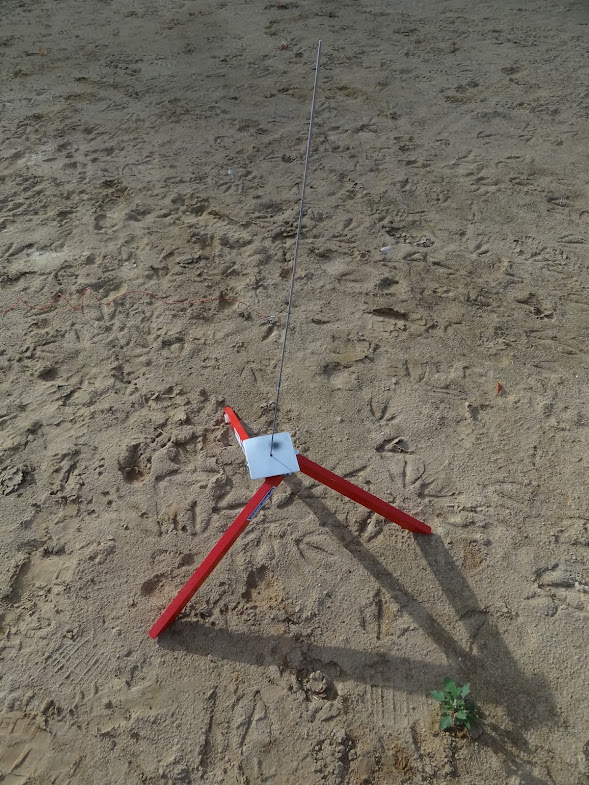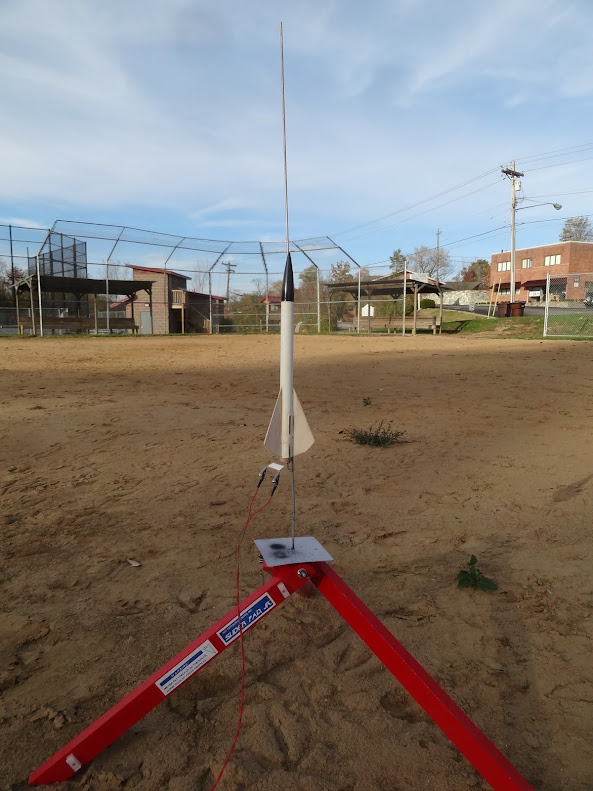Vacation day, and with the spate of Indian Summer we're experiencing and an empty B6-4 Field, I couldn't think of any reason not to take advantage of the day to launch another batch of unflown or seldom flown rockets. I arrived after lunch at the school because I wasn't sure where the kids played for recess and I knew an army of kids would kill any chance of making a dent in my box. As it turned out, I needn't worried.
Winds were nonexistent, but the field was strangely damp despite several days without rain. I set up on the infield near shortstop and chose the Estes Generic E2X as the first flight on the afternoon. It had flown before, but never in full livery. Well, close to full. Only an 8 year old would have used all of those stickers.
This set the baseline on flights for the day. With the lack of any breeze at all the A8-3 flight was arrow straight to about 250'. Recovery happened in short center field without incident. I hoped it would be a harbinger of things to come.
The New Way Check It has also flown before, but as with the Generic E2X it would be the first time in full livery. The flight would be on a 1/2A3-4T, but based on the low level flight a full A would have been a better choice.
The Check It is a fairly beefy bird, and obviously struggled to gain altitude off the rod. It appeared to peter out around between 100' to 150', then recovered without damage despite the parawad recovery. Apparently the square tubing could use a sheet or two of wadding in addition to the dog barf. In the future this will likely be an A3 or A10 bird.
Flight #3 would be an Estes Screamer that I've had for several years. I picked it up in an Ebay lot, and it was so poorly built that I almost pulled the nose cone and tossed the body. In the end I replaced the rotted shock cord and decided to give it a chance to fly.
I debated the engine choice on this one, deciding between the 1/4A and the 1/2A. In the end I went with the 1/2A, mostly because of the lack of oomph the previous rocket had shown on that engine. This one certainly didn't lack for oomph. The Screamer did just that, screamed off the pad. Had conditions been normal with even light breezes this rocket would have been gone. As it was it came quite close to the trees on the edge of the field.
The MRC Firefighter would be my next first flight bird. It's the last of my MRC trio to fly, and likely to be the most durable of the three given that it doesn't seem to use the same typing paper-thin tubing that the other two were saddled with. This tube feels more like the Estes tubes, or since the nose cone is the same as the current ATW cone, Custom. No decals yet. I can't find the sticker set and the clown who scanned his set for YORF didn't scan them flat, so they have shadows. (Hey, I was new to scanning. Cut me a break.) I tried cleaning up my scan to get a workable set of waterslides, but the results were iffy.
First flight would be an A8-3, standard for minimum diameter 18mm birds at B6-4 Field. That might have been too much. I missed the launch shot when the launch was delayed, something that should have tipped me off to the problems I would experience later in the launch. The streamer may also have been an iffy choice. The flight was very high with a pronounced arc to left field, a "can of corn" in baseball parlance. Ejection occurred just as it tipped and the streamer streamed, but the rocket recovered noticeably fast.
No stream to this one, and the body did nothing that looked like floating. It was a flat out speed run toward left field with the body tube leading the way. The outfield was mostly grass, but football practices have left some bare spots, and the Firefighter found one. Solid contact, but the ground gave way nicely and the dirt was easily blown out when the expended engine was removed. Gave me bad breath, though.
Flight #5 would be my only B6-4 flight of the day, my newly finished
Polaris XL, a BT-55 upscale of the old gold, blue and white Estes
Polaris. The donor kit for this build was one of the Estes clearance Phoenix Bird kits. I built one as intended, but somehow opened two, so I scanned the old catalogs for a likely 4FNC upscale. I always liked the old Polaris, and the tube slots seemed to be made for it.
The flight was dead straight to around 300 feet, possible trouble in breezy conditions, but quite majestic in the dead calm that this day brought. Come back anytime. Tell your friends. There was no drift at all on recovery, possibly due to a tangled shroud line. The big Polaris came down fairly fast and hit the infield fairly hard. Scuffed one balsa fin, but not enough that most would notice. Looking forward to getting this one painted, and hopefully I'll be back printing soon and can try my hand out on making the decals.
The Tau Zero Prometheus qualifies as a seldom flown bird, having flown last 8 years ago. That flight ended with a kinked body tube as a result of an ejection rebound, so I hoped this one would be different.
Another A8-3 flight, this flight was a carbon copy of the Firefighter except for a slight drift toward center field. The flight would have been perfect if not for another audible thunk at ejection. Even before it hit the ground, sticking the landing on one of the unbroken fins, I knew that there would be damage. The contact was too loud, as was the ejection charge. Sure enough, one of the fins was broken and holding on by only the slightest of threads. In fact, when I turned the model over looking for impact points the fin fell off. Snakebit. Tune in in 2023 for the next flight.
Some rockets get built for the oddest reasons. The Vector came about because I had an original decal sheet that came in an Ebay lot back in the pre-Paypal days. It was one of several that I guilted myself into building just because. Truth is, I like having reasons like this to clone obscure BT-5 birds. Who else would fly them if not me?
This flight would be the 1/4A flight that the Screamer should have been. Plenty high for the field, and dead straight. Everything worked as expected, including the thermonuclear ejection charge. Even with the extra ejection umph things went well. The Mylar streamer streamed and glinted as hoped. The rocket landed on the infield near pitcher's mound.
Oh, and it stuck the landing. Twice. How often do you get to see this? It occurred to me as I typed that the Vector would have been another great potential design for that BT-55 upscale I was looking for when I did the Polaris. Wonder if I have another Phoenix Bird kit in my clearance stash?
Final flight for the day would be the Ebay Fougee, a kit I bought in a lot last spring, sure that I'd seen the design before. Well, I was wrong. It needed a new shock cord, and was old enough that the previous one had been attached through two slits in the body tube. I replaced that dried out husk with a piece of Kevlar and some old Estes elastic, and was really looking forward to flying it. While it looks like a two stager, it's actually single stage, so the flight would be on an A8-3. No launch picture. It was this flight that convinced me that my batteries were dying if not dead. I had cycled through a complete camera burst and dropped the launcher when it took off. It did the same lazy can of corn flight path that several others had done on the day, but this ejection charge was like a bird fart and didn't clear the old chute. The Fougee came in on the same path as the Firefighter had, but the upper body tube buckled where the slits had been cut. This might be a one flight wonder, but at least it flew. I packed up, beat the after school traffic, and headed to Lowes to treat myself to a large pack of AA batteries, enough to replace the current four in the launcher, and extras to keep this from ever happening again. The old dog learned a new trick.

































































